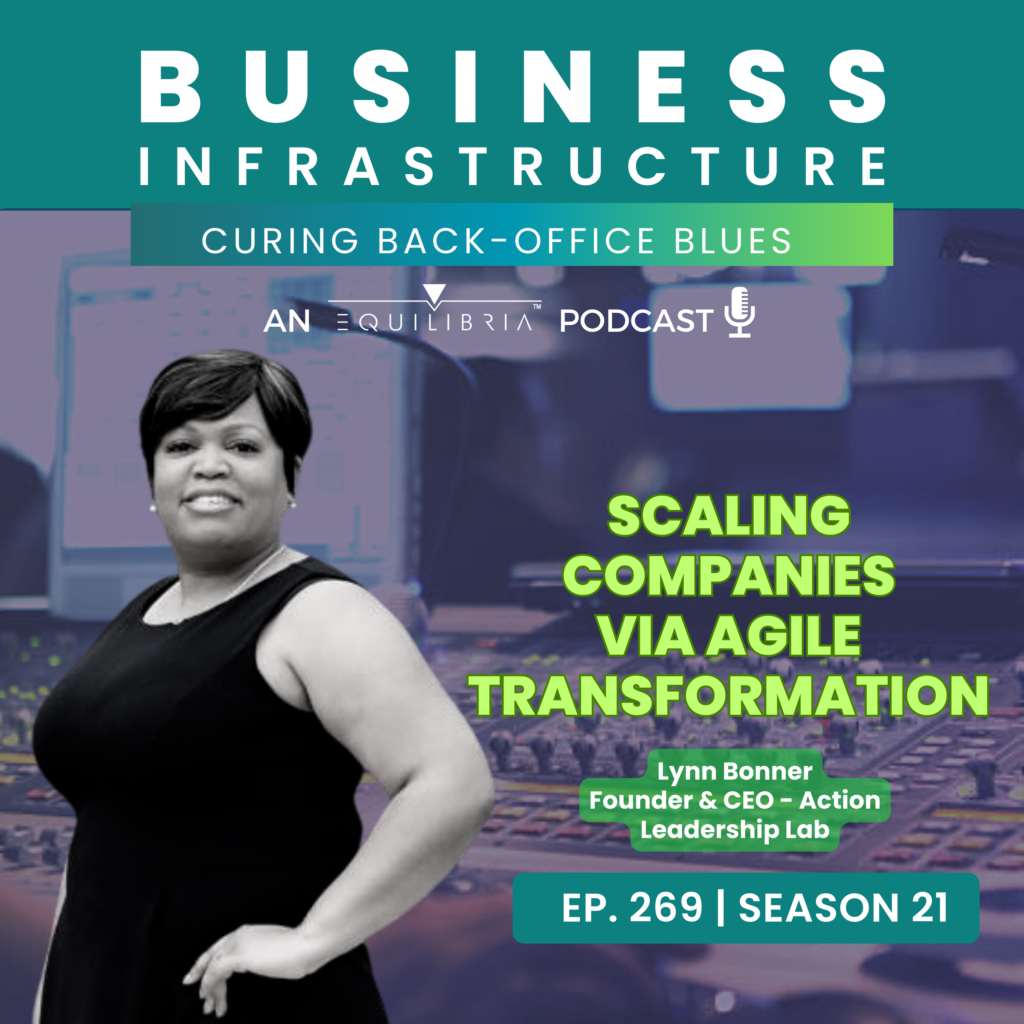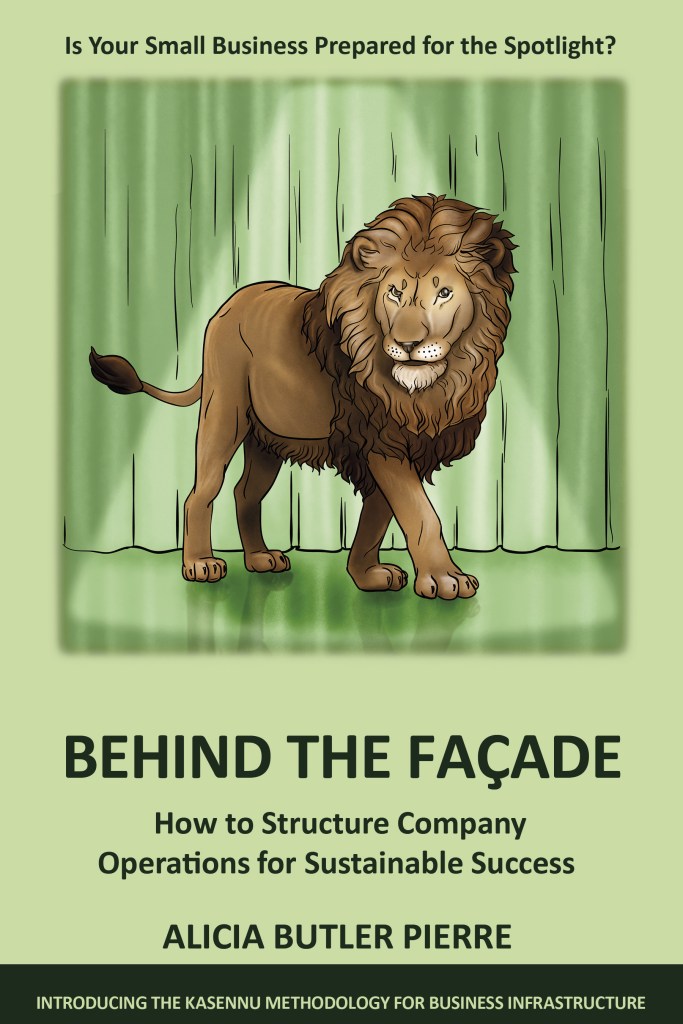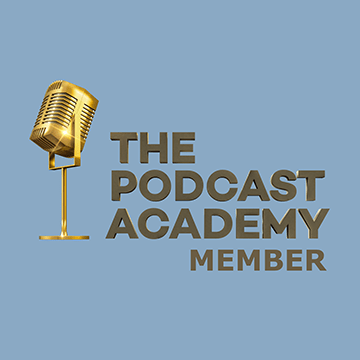Transcript
This podcast is brought to you by Equilibria, Inc. We design business infrastructure that frees you from the chaos of fast growth, scales your operations, and increases the value of your small business.

Hi, how are you? I’m so glad you’ve come back! Come on in so that we can walk over to the podcasting vault. Grab a seat and those headphones while I load up the next remastered episode for you. It’ll convince you of the power of intentionally working in smaller teams with smaller chunks of work to accomplish your bigger goals.
This is Season 21 of the Business Infrastructure podcast. On this show we share operational tips, strategies, and tactics to help you cure any back-office blues you might be experiencing.
What if I told you that bigger isn’t always better? That might sound crazy, especially since scaling a business is about expansion, but what if the key to expansion is actually… contraction?
Hi, I’m Alicia Butler Pierre, and you’re about to hear why in our next episode selected for remastering this season.
Growing your company in small, incremental, and highly intentional steps packs a powerful punch and unleashes your company’s tipping point. Consider that the most potent effects come from concentrating your efforts and not diluting them with large, siloed teams. It requires agility, alignment, and action. Are you ready?
This is Episode 269 – Scaling Companies via Agile Transformation with Lynn Bonner
It’s always exciting to interview someone who lives and works in the same city as me, the one and only Atlanta, GA. Lynn Bonner is the founder and CEO of Action Leadership Lab. Her company offers business productivity and agile transformation training for leaders, coaches, and entrepreneurs. She’s also a VP at US Bank. Let’s welcome her to the show, find out how she’s doing, and also ask her how in the world she’s able to run a business while also serving as a VP.
I am awesome. Thank you so very much for having me. I do it out of love. I’ll say that it’s intentional congruency if that makes sense. What I do at US Bank is all around the transformation coaching, and training, really helping the organization move forward in their own agile journey. And then at the exact same time in my business, I pretty much do the same thing. I go from business to business helping them look at their processes, look at how they are utilizing the best of their people, and really rethinking how
to structure things which is extremely important right now when you are basically forced to do even more with less. But you have to be sure that you still protect the most important thing of your business which is basically your people and your system. So, I love it, that is right up my alley. People and processes are definitely my thing and I do it with happiness.

Now that we know the link between what Lynn is doing in her role as VP at US Bank and Action Leadership Lab, I wondered if she could tell us what made her want to start her own business.
I started with the thought of leadership skills that are needed whether you are running a business or whether you are already working for someone else. I think it’s good to do both sometimes. And what I kept finding is although there were moves I wanted to make, there were still people that I felt needed help that had no exposure to what was happening in corporate I.T. But they wanted to be in corporate I.T. So, it became a way of sharing that information and helping people get exposure and insight and start putting their minds around what really happens in that space. Because it’s different. It’s different from a nonprofit, it’s different from being the leader of a PTA.
It’s a very different world and people were interested but they didn’t have anyone who could help them see that bigger picture. So that was kind of one piece of it and then the second piece was I kept hearing of people wanting to start businesses, but they didn’t know where to start and the biggest fear was to start. And so, the business came from really a need to help people take action, which is why that’s in the name of the business because we will think and plan and strategize for months and not actually make any moves. And so, it was really taking the action from a leadership perspective and giving them an opportunity to experiment and test out because that seems to be the other fear with people.

They’re afraid to fail. I put that in air quotes and there’s no such thing. You’re testing things out; you’re figuring out what works and what does not. And in entrepreneurship that is extremely important and it’s just as important in the corporate I.T. world where we are testing things out with our customers and our clients. We’re putting things out there and we’re saying, “Do you like it? Do you not?” And pulling it back. There’s no difference between the two.
So, it sounds like what you are describing, and I have seen this on your company’s website as well, is digital transformation. But you also talk about Agile transformation. So, can you explain to those who are listening right now, Lynn, what does that mean exactly?
Yeah, I will do my best. So, when I think about Agile transformation, I think about it more from a set of principles and a different mindset to approach the work. So, if I put that into action, it’s really around taking down all of the silos and the ways in which we’ve split up organizations and really putting together, if you want to call it team or team of teams that can holistically bring themselves to a piece of work. So, you’ve got them working, well rephrase that, bring the work to them, meaning they are able to
go from understanding the problem, thinking through how to fix it, and then actually getting it out the door. And they stay together because you’re building that energy and that synergy, and they start to get really great at working together. And so that’s really more agile principles, mindset, and the way in which you work. Digital transformation is really taking components of agile and looking at it more from a system, tools, processes, and really looking at how to additionally streamline your business from top to bottom. So, an example of that is there are still businesses that have fax machines.
There are businesses that still require that you show up in person. And so those things are where you really start to think about agility and digital in a very different way, right? So those are kind of two ways to really approach the agile transformation and then the digital side of the house both.
I don’t know about you, but after listening to Lynn describe the agile and digital transformation and the difference between the two, I’m curious about who her typical clients are.
There are two sides, funny enough. There’s one side that’s more of the individual who is looking to upskill themselves and looking to potentially open a business. So that’s more of people that look like me. I am a black woman in Atlanta. And so, they’re really looking to understand how to think about business and how to think about positioning themselves for executive leadership roles. So, they’re either doing one or the other. Some are doing both, sort of like me, and then the other customers that I tend to look
for small to medium-sized businesses that are seeking help and streamlining their processes.
Some of them are one to two-owner partnership types of businesses that started and are feeling a ton of pain because their processes aren’t working. They don’t have the right people in the right seats. They’re not sure which way to go. And so now they’re just kind of trying to hang on versus stopping for a moment and thinking about, here are the next steps for us. So really helping them map out the strategy and then taking that strategy into implementation, which is also a place where for some reason, people
have a really hard time. They think about the strategy all day, but now it’s time to move. And they’re like, “Hang on, I need a few more months, a few more years to think about that.” And things are changing every day.
Indeed, they are. And I’m glad Lynn mentioned how challenging it can be for some people to implement their company’s strategy. With that in mind, I wondered if Lynn could share how she implemented her company’s strategy to grow and scale their operations.
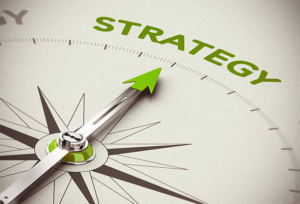
Hmm…so, it started off a little scary. I’ll say that because it’s a new business and you’re like, what am I doing? But then it starts to grow I started off as a one woman show. And so, it was you got to be the marketing and the sales and the trainer and the one delivering the trainings. And so, it has since evolved into having a small team of people. So, I have the people who help do the trainings and help to kind of go out and have the conversations. I still do that from time to time, but it’s hard to do as a VP, so I don’t do it anywhere near as much. And then I also have my back-office team that is taking my vision and my strategy and kind of taking that information and helping to implement it. And we use all kind of tools to stay in sync.
I use agile principles and mindset in how we run the business. That’s actually how we were able to scale and move so quickly is because we do sprints, we do quarterly planning together. We all sit down and talk through what do we want to do. And here’s my big mission and many missions for the next few months and really help them understand where we’re going. Because I do think having a clearly articulated strategy for what we’re trying to do has moved mountains. Because before it was like, Here’s
all these things we need to do and it’s like, “But why are we doing it and where are we going and who are we serving?”
And in my mind, that was a really simple thing. Well, I didn’t articulate it very clearly, okay? So, once I started articulating what we were doing, we took off. Because now everyone is marching in the same direction because they get why we are reaching out to certain clients. They understand why we are delivering things in a certain way. They understand what the outcomes are. When I say, “Please go here and do these things, it’s not a task anymore. It’s more of a mission. I’m all about a mission.”

Well it sounds like a mission, accomplished! That was a great point Lynn made about clearly articulating the strategy as well as the mission so that everyone knows what they’re working toward. Kind of like having a North Star that guides all work.
Once you get there and people connect with it, there is a strength and an energy. You have to come at things with a bit of a passion for it. If you don’t like it or if it drains you, you’re not going to be very good at it, right? Because you’ll procrastinate at it, you’ll avoid it like the plague. But if it’s something that you enjoy and as you’re working with your teams and you’re getting them to see where they’re going, and you can very quickly ascertain who’s really enjoying what they’re doing and who’s just looking for a job,
you can weed that out very quickly. But that energy and that wind beneath your wings type of things will actually lift people to go and do things when there’s a purpose, there’s a mission. At the end of the day, we are helping someone see themselves differently and show up differently. We can put a lot of fancy words around it, but at the end of the day, seeing that light bulb goes off for people is beautiful to me.
And you know what else is beautiful? Having a solid business infrastructure to support your company’s mission and strategy. Considering the three elements of business infrastructure – people, processes, and tools – I asked Lynn if she could next share more details about how she built her team.
I actually have a team of three, and that team is ultimately responsible for a few things. They are my tech person. I have someone who’s really good at the marketing piece. And then I have one of my masterminds – she helps me with keeping track of all the things that we have going on and she acts really as my right hand from an administrative perspective. So, I’ve got the vision, the strategy, but I’m also very much like, Well, what are we doing with this? And so, she helps really pull that all together in terms
of people. I do an onboarding process for each one of my team members because I want to know very quickly how they react to different things. As you can tell, I’m very energetic, so I tend to look for people that are going to have a similar energetic profile. Unless, of course, there’s something that really is an individual activity. Like, my tech guy really isn’t that talkative.
He’s not as engaging. But he is wicked smart. He does things really well, and he knows when to connect when it’s most important for him. And so really being open to the different personalities and the different ways that people show up because one of the tenets is that people should get to show up as themselves. And so we do Kolbe assessments. We do an Energy Leadership Index or kind of gives us an idea of where people show up energetically when they’re at their happiest and when they’re stressed out.
So, we do those type of assessments just so we know who we’re working with, which also determines how we best interact with each other, because the key to a team is we know how to engage. I’m a morning person. Not all of my team is. So, some things I’ll reach out later in the afternoon because that’s when they’re at their peak. So you just start to really gel as a team once you understand one, the skill sets, because that is still a key. And then the aptitude to learn, the willingness to take on something else
or to share skills throughout the team so that they don’t get so bored, that’s also key for your people. They want excitement and newness, too.
It’s obvious Lynn’s proud of her team. In fact, if you go to her company’s website, you’ll find a reference to the superheroes known as the Avengers. It’s such an awesome analogy to the A-team that Lynn’s built. Although they each have their own unique superpower, even greater things happen when they come together and function as a team.

Individually, they are absolutely strong. They each have their own superpowers. Showing up, being authentically you is absolutely important. But when you bring those skill sets together, I am always amazed at how much we get done. I mean this is literally…we’re not talking about a gigantic back-office team, right? I don’t have 1000 marketers and tons and tons of people. But the back office, the people that are responsible for keeping the essentials moving, do a ton for me. And because they gel so well, they know when to reach out to each other and they know how to best engage. And that synergy can’t be purchased. You can’t buy that. It has to be built really with experience and with working together. It’s a beautiful thing to watch.
What a great feeling to have a team that’s in sync with each other and plays off of each other’s strengths. Coming up after the break, Lynn will share more about the other two elements of business infrastructure – processes and tools – that she uses to scale companies in an agile way.
In the world of business, success isn’t just about great ideas or products. It’s about having a strong foundation—a solid business infrastructure. But why is it so important?
A robust business infrastructure is like the backbone of an organization. It provides the necessary support for all our operations.
Business infrastructure ensures effective communication and collaboration. It allows teams to seamlessly share information, work together efficiently, and make informed decisions.
It also enables efficient data management. With proper systems in place, businesses can securely store, analyze, and utilize their data to gain valuable insights and make strategic decisions.
Thirdly, a strong business infrastructure promotes innovation and growth. It provides the flexibility to scale up operations, adopt new technologies, and adapt to changing market demands. It’s no wonder why a solid business infrastructure is essential for success. It enhances communication, facilitates efficient data management, fosters innovation, and enables flexibility—all vital for businesses to thrive in today’s
competitive landscape. Invest in a strong business infrastructure, and watch your business reach new heights!
At Equilibria, we’re excited to offer a free webinar opportunity where we’ll do a deep dive into business infrastructure. Stop being a victim of unmanageable fast growth and start building your own company’s business infrastructure. Don’t wait! Experience the order and calm that thousands of other small businesses have. Sign up now at SmoothOperator.Club. That’s SmoothOperator.club.
We’re back and before the break, Lynn Bonner, a systems and process-loving team-building expert who also specializes in agile transformation began sharing how she scaled her company and others. It all starts with having the right people performing the right functions on your team. But there are also certain processes and tools she leverages. Knowing that she’s all about taking action, how did she put those in place as she
scaled her own business? Here’s Lynn.
I went along the way, and I can’t remember which book it was that said you needed to do everything at least once. And I read it and I thought, Yeah, I’m at the place where I’m doing it all a lot because I was a woman. That’s really funny, right? So, then it was like, okay, I got the first person on the team. Here are the things I’d like to transition with you. And I found that…I test it. Like, I am all about figuring out the right way. Because if I run through it all one time and document it, but then I don’t actually sit with you to do it a couple of times, did I miss a step that’s now creating your angst? So those type of things. And so, I really test it out a few times. And then, of course, if you use Zoom or Loom, which is actually free, you’ve got all these different ways to literally be able to talk through and screen share and be able to video record what you’re doing, which I found is the best way, because people can hear your voice, they can see what you’re doing.

They can hear your thought process. Once I did that a few times, I would then have my Mastermind start to create a document for me, depending on different types on my team. Some people are very videos, some need a step-by-step guide. And I imagine that as we grow, we’re going to continue to have to balance out the different ways in which people learn.
And that’s a key thing to remember about processes – they are not static. They will (andmshould) change and evolve as your business continues to grow. There were also some tools that Lynn mentioned earlier in assessing people’s skills. Let’s find out more about those.
With the Energy Leadership Index, it gives you a view into how you view the world. It asks you a series of questions, and it basically ascertains how you show up energetically. And so, this Energy Leadership Index really looks at how you react to things when things are going well and how you react when things don’t go exactly according to plan. So think stress. And with that information, you are now able to, one, be more aware. Everything starts with awareness.
And then that second piece, once we do that Leadership Index, we’re able to take that information and now talk through a strategy and a plan for how we will engage going forward. So, an example of that is if I have someone who, when things don’t go well, they go straight to anger, then in that case, one, I recognize it, and two, they are now aware that I recognize it. And so, with the rest of the team, we’re really now talking about “please don’t take it personally” when they go to anger. Right. Imagine how important that is for someone who didn’t hear that. And someone gets ticked off, and they’re like, Oh my gosh, I did something. And now you’ve got two people, one that’s mad and one that’s now hurt because they think they did something. Give them a moment and tell the person that’s angry.
When you get stressed, you do this. So go find something else to do for a little while and then come back. And for the person that they’re talking to, please don’t take it personally. Right? And then we need to talk about all of the things that come, because we’re all people at the end of the day so, you really have to give people some space and start to train and coach and support them through one, try not to show up angry. Two, for everyone else, please be aware of the emotional state because it will help or
hinder how a team engages and how they start to build and how they gel. And so, I love it because it helps me, it helps me with that insight. I don’t have to guess anymore.
Okay, so that covers one of the tools Lynn previously mentioned. But what about the other one? The Kolbe A Index.

I love the Kolbe too. The Kolbe gives you a really good idea of how people…their default way of getting things done. So, for instance, if you think about it, for work, for us, I am what they call a long line. Can’t even think of the word, but basically, I love systems and processes.
I go straight to What’s our system and our process for this, and how are we going to make sure everything is streamlined? So that’s just naturally how I show up. It’s naturally how I speak, and how I solve problems. It’s everything. But then you have some that are more in that fact finder. So, they’re going to go and look up every single piece of detailed information they can find. My husband is one. He’s going to watch YouTube videos, he’s going to read several books. He’s going to read articles; he’s going to reach
out to experts. And for me, I’m like, here’s the question, here’s the process, here’s the answer, and I’m gone, right?
So just understanding how people show up is really key because then it will gauge how you give them instructions, how you’re working with them. When I talk about the mission and the mini missions, I’m very careful in how I say it because now I know how each individual is likely to take it. One will think about a system and a process. One will just hop up and go. One will need me to actually draw out a process flow, documented and written so that they can see things. So, I really have to be able to use that information to best engage and move people towards action because that’s the key when we leave these strategy meetings and planning sessions.
Now that we have a better understanding of how she leverages the Energy Leadership Index and the Kolbe A Index, I asked Lynn if she could spend some time explaining what it means to have an agile organization.
The Cliff Notes version would be small teams focused on the smallest pieces of work they can do in a small window of time. So, in this case, typically think less than a month, or two weeks is ideal, and they can do this repeatedly throughout the year. So, every two weeks, this small team will plan, do the work. They’ll check in daily and then at the end, they will figure out and look at what they’ve completed and what they didn’t and figure out what they can do even better next time or what they want to keep as
their team norms going forward. You will incrementally complete small things to get you to a much bigger outcome.
So instead of attempting to implement a strategy or work on a project full throttle, break it up into smaller, more digestible pieces of work. This not only gives you quick wins but also enables you to isolate potential problems and pitfalls sooner rather than later. There are some other tools that Lynn recommends as well – tools to help you document and manage your agile-based work.
Headliner is an easy tool to use if you are trying to either do video or if you’re trying to do really audio podcasts, but you still want it to look like a video when you put it into social media. So, it’s visually appealing when you are trying to post things mainly on social media. But there are other applications that we use it for as well like training videos and things like that.
Use a tool that fits your personality. I love Asana, it’s very similar to Trello and some of those other tools. If you’re someone who likes to see details, I think either tool will work. I tend to like to see things at that mission goal level because I want to see how we’re tracking to things, which is another reason why I love Asana. So, find a tool that works for you so that you can see achievement so that you can see completion, so that you can see how you are building towards the next set of goals.
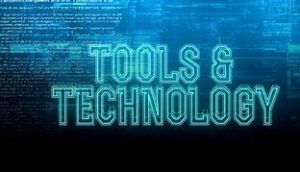
The other piece I would say is actually have goals. Really have intention around what you are doing in the business. And be sure that not only do you know what the intent and reason of why you’re getting up every day doing what you’re doing but be sure you have ways of communicating to your organization. Whether it’s a team of one being you, or if it’s a team of 2050, depending on what you’re doing. You want to be sure that everyone knows what the intent is so that they’re all marching in the same direction.
And finally, we can’t end this interview without Lynn telling us more about her company’s training courses.
We have our Action VIP days. Those are really a one-day session for those that need some help around, not only getting intentional about their strategy, but starting to build out that implementation plan. Now, of course, we can’t implement your entire business in one day, but we can certainly sit down and talk about all of the key elements that you need and also talk about scaling. So, if you’re someone that’s in that entrepreneurial or even trying to get into executive VP, we can also sit down and map out through the assessments what type of things you need to be looking at. So, it’s really a customized day, either one person or a small group. Small groups are absolutely fabulous. We also do the same thing for our B-to-B clients who reach out that are like, we need help with our portfolio management, or we need help with really mapping out our customer journey. Like, how do we get customers in all the way down to getting feedback for them?
Because I love systems and processes that’s right up my alley. So really help with all of those things. And then for the online classes, we have The Collective. And The Collective is a space to essentially pick and choose the classes that you want to, some of them are around the interpersonal skills and the focus on you. Some of the classes are focused on more of the business transformation. So, for those that are in that coaching, digital coaching, agile coaching, business coaching space, and that are looking to understand how do I lead a transformation, what type of components and aspects of a business should I be looking at? That collective has trainings in there around that as well.
Well Lynn, it has been a pleasure learning more about you and the transformative work that you and your team do for individuals and businesses alike.
Thank you. This was absolutely fun! We’ll have to do it again.
Oh, don’t worry, Lynn, we’ll definitely figure out the best way to have you come back onto the show. For now, if you want more information about Lynn, her training courses, and the other resources she shared, then go to BusinessInfrastructure.TV. Again, that’s BusinessInfrastructure.TV. There you’ll be able to quickly access that
information.
Thank you for listening! If you enjoyed this episode, then please subscribe and leave a five-star rating and review.

Well, this concludes our time together…for now. Let’s go ahead and get out of this podcasting vault. But make sure you come back, okay? We’ll have another remastered episode for you to hear as we wind down this season.
Until then, remember to stay focused and be encouraged. This entrepreneurial journey is a marathon and not a sprint.
This podcast was written, produced, and narrated by me, Alicia Butler Pierre. Audio editing by Olanrewaju Adeyemo. Original score and sound design by Sabor! Music Enterprises.


